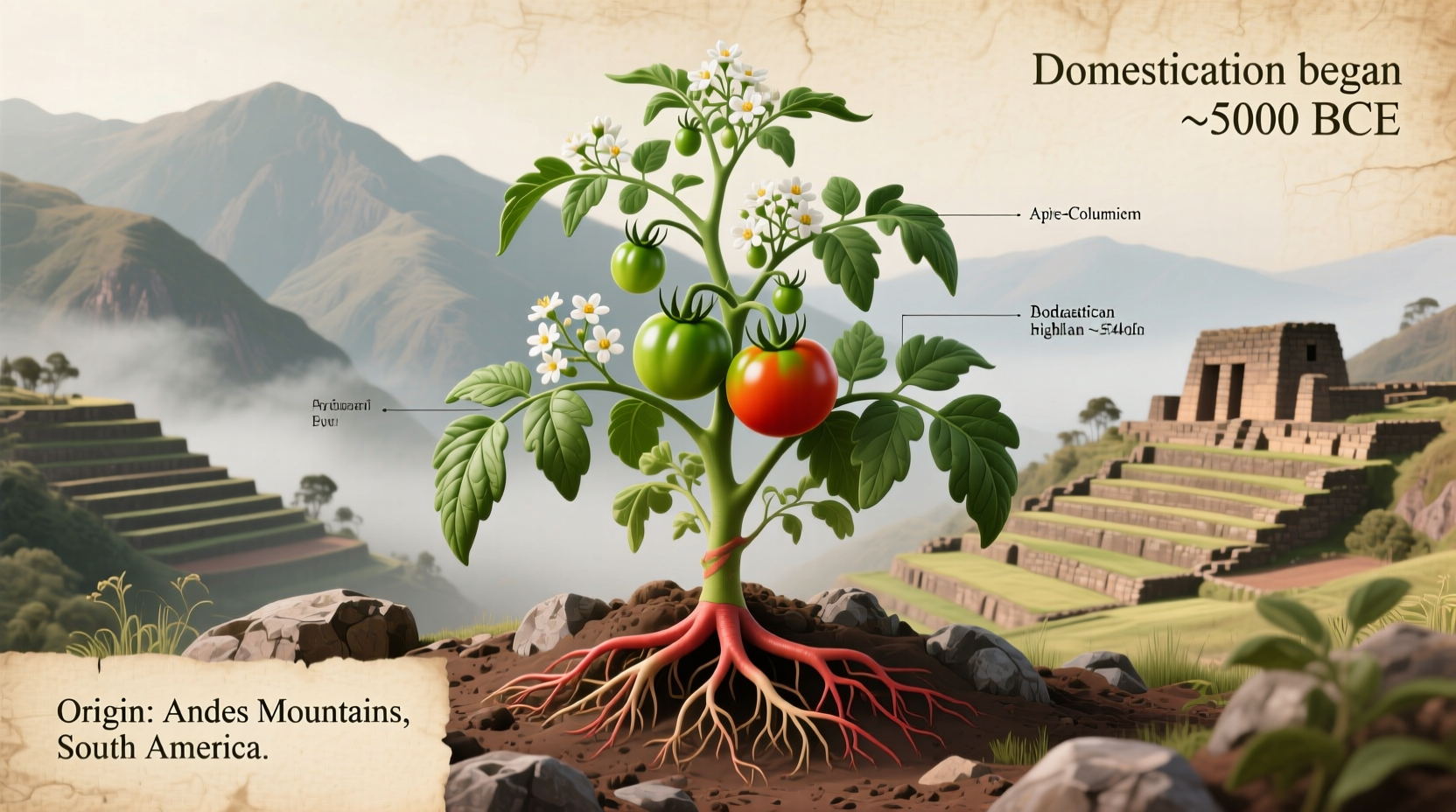From Wild Berry to Global Superfood: The Remarkable Journey of Tomatoes
For gardeners, chefs, and food enthusiasts alike, understanding the true origin of tomatoes reveals why certain varieties thrive in specific conditions and how centuries of cultivation shaped the flavors we enjoy today. This botanical journey explains why heirloom tomatoes often taste more complex than modern hybrids and how ancient growing practices still influence contemporary cultivation techniques.
The Ancient Roots: Where Tomatoes First Grew Wild
Wild tomato ancestors (Solanum pimpinellifolium) evolved in the arid coastal regions of western South America. These small, berry-like fruits with intense flavor still grow wild in Peru, Ecuador, and northern Chile. Unlike today's cultivated varieties, wild tomatoes were about the size of blueberries with a tart, complex flavor profile that early humans found appealing.
Archaeological evidence from the Tehuacán Valley in Mexico shows tomato seeds dating back to 500 BCE, indicating domestication occurred after indigenous peoples transported seeds northward. The Aztecs called them xitomatl ("plump thing with a navel"), incorporating them into early versions of salsa that remain culinary staples today.
| Tomato Evolution Stage | Time Period | Key Characteristics |
|---|---|---|
| Wild Ancestor | Pre-500 BCE | Small berry-like fruits (1-2 cm), high acidity, complex flavor |
| Early Domestication | 500 BCE - 1500 CE | Larger fruits (3-5 cm), reduced acidity, diverse colors |
| European Introduction | 1520s - 1700s | Yellow/orange varieties called "pomi d'oro" (golden apples) |
| Global Cultivation | 1800s - Present | Red varieties dominate, specialized breeding for disease resistance |
The Scientific Classification Puzzle
Botanists initially classified tomatoes as Lycopersicon esculentum, but modern genetic research confirms they belong in the Solanum genus alongside potatoes and eggplants. This reclassification in 2005, documented by the USDA Agricultural Research Service, reflects their close evolutionary relationship with other nightshades.
Genetic studies published in Nature Genetics reveal that just three key mutations during domestication transformed wild tomatoes into the larger, juicier varieties we recognize today. These mutations affected fruit size, color, and ripening patterns - explaining why heirloom varieties often display greater genetic diversity than modern hybrids.

How Tomatoes Conquered the World (Despite Early Skepticism)
Spanish conquistadors first encountered tomatoes in Montezuma's gardens in 1519. They brought seeds to Europe, where tomatoes were initially grown as ornamental plants due to suspicions about their nightshade family membership. Many Europeans believed tomatoes were poisonous - a misconception that persisted for over 200 years.
The turning point came in 1820 when New Jersey resident Robert Gibbon Johnson publicly ate tomatoes on the Salem courthouse steps, debunking the poison myth. Meanwhile, Italian and Spanish cooks had already embraced tomatoes, with the first known tomato recipe appearing in Italian chef Antonio Latini's 1692 cookbook Lo Scalco alla Moderna.
Modern Tomato Diversity: Connecting Past to Present
Today's tomato varieties reflect their complex journey. Heirloom varieties like 'Brandywine' and 'Cherokee Purple' preserve genetic traits from early Mesoamerican cultivation, while modern hybrids like 'Roma' prioritize disease resistance and shipping durability. The International Tomato Genetics Resource Center maintains over 10,000 tomato accessions, preserving genetic diversity critical for future breeding.
Gardeners can apply historical knowledge to improve cultivation: tomatoes still thrive in conditions similar to their Andean homeland - warm days, cool nights, and well-drained soil. Understanding their South American origins explains why tomatoes struggle in consistently humid climates and why certain heirloom varieties perform better in specific regions.
Practical Insights for Gardeners and Cooks
Knowing tomato origins helps optimize growing and cooking:
- Soil requirements: Mimic Andean volcanic soils with well-draining, slightly acidic mixtures
- Watering patterns: Simulate seasonal rainfall with deep, infrequent watering
- Variety selection: Choose heirlooms for complex flavors, modern hybrids for disease resistance
- Cooking applications: Use smaller varieties (closer to wild types) raw for salads, larger varieties for sauces
When selecting seeds, consider their historical adaptation - Mexican varieties often tolerate heat better, while Andean types may handle cooler temperatures. This ancestral knowledge, documented by agricultural researchers at the University of California, Davis, helps gardeners match varieties to local conditions.
Frequently Asked Questions
Did tomatoes originate in Italy as many believe?
No, tomatoes originated in South America. They reached Italy through Spanish explorers in the 16th century. Early Italian cookbooks didn't mention tomatoes until the late 17th century, confirming they were New World imports.
Why were tomatoes initially considered poisonous in Europe?
Tomatoes belong to the nightshade family, which includes several toxic plants. European aristocrats using acidic tomato dishes with lead-glazed pewter plates experienced lead poisoning, mistakenly blaming the tomatoes. This misconception persisted until the 19th century.
How did tomatoes become red instead of yellow?
Early European tomatoes were mostly yellow or orange. The red varieties we know today resulted from selective breeding in 18th-19th century Europe and North America. Genetic research shows a mutation in the Del gene increased lycopene production, creating the deep red color associated with modern tomatoes.
Are wild tomatoes edible today?
Yes, wild tomatoes (Solanum pimpinellifolium) are completely edible and prized by chefs for their intense, complex flavor. They grow spontaneously in Peru and Ecuador and are increasingly available from specialty seed companies for home gardeners seeking authentic ancestral varieties.
What's the difference between heirloom and hybrid tomatoes?
Heirloom tomatoes are open-pollinated varieties passed down through generations, preserving genetic diversity from early cultivation. Hybrid tomatoes result from controlled cross-pollination to combine desirable traits like disease resistance. Heirlooms often have superior flavor complexity while hybrids offer more consistent yields and durability.











 浙公网安备
33010002000092号
浙公网安备
33010002000092号 浙B2-20120091-4
浙B2-20120091-4